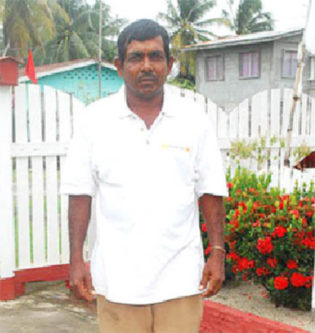Rice farmer and President the Essequibo Paddy Association Naith Ram says that the transformation in the fortunes of Region Two rice farmers in the wake of the disappearance of the PetroCaribe agreement with neighbouring Venezuela has been nothing short of dramatic. Significantly reduced earnings have been accompanied by a sense of gloom and what in some instances is a desperate search for options.
The profit margin these days is “very small. Those farmers with more than 20 acres of land may be able to cover production cost, but those farmers with one, two or less than ten acres are feeling the pinch. They will find it difficult to survive without another form of employment to supplement their incomes,” he says.

In its heyday the PetroCaribe Agreement had brought rice prices of up to US$700 per ton. These days, he says, US$375 is considered “a good price.” Still, rice continues to be the mainstay of the Essequibo economy and the main source of income for families. The decline in price has seen no reduction in the acreages under cultivation. All told, an estimated 34,000 acres of rice is cultivated, but the farmers are brooding. The millers on the Essequibo Coast are offering between $1,800 and $2,300 per bag of paddy. The farmers are unhappy. They are aware that their counterparts in Berbice receive between $2,500 and $2,800 per bag. But their own choice is limited. The millers say that paddy prices have to do mostly with what it costs to transport the rice to Georgetown. This is expensive and hence the reason for the price of paddy.
Ram crunches more numbers. He says it costs around $60,000 to produce an acre of paddy. At the current selling price for paddy ($1,800 – $2,300) the Essequibo rice farmer will receive between $59,400 and $75,900 for that acre of paddy. Their Berbice counterparts, he says, earn between $ 82,000 and $92,400 for an acre of paddy.
The Essequibo Paddy Association official refutes the claim made by the millers regarding transportation costs. He says that transportation costs for Berbice millers is greater. In this regard he is supported by Mohin Persaud of Nand Persaud and Company.
What has improved, Ram says is the promptness with which millers make payments to farmers though there are still instances of delays in making payments. He is aware of outstanding payments to a group of farmers totalling around $15 million since 2015. That has a knock-on effect, chiefly in terms of outstanding loans to commercial banks. He is advocating more competition in the milling sector and possibly a state-run rice mill.
In an effort to provide a measure of relief to the farmers the Guyana Rice Development Board has been providing fertilizer on credit to rice farmers in Regions 2, 5 and 6 through its sub offices. The cost of the fertilizer on credit is $5,500 per bag, compared with the current price of $5,800, an initiative which Ram says has provided a modest measure of relief.
Persaud says Essequibo rice farmers face challenges associated with pest infestation that negatively affects the quality of rice and that should be reduced or eliminated.
With the Essequibo rice community anxious to secure new markets, Nand Persaud and Company has been busy in Region Two. The Berbice rice magnate disclosed that over the past three weeks the company has purchased 500 tonnes of rice weekly from rice millers, paying in cash. That way, he says, his company hopes to contribute to reducing the current financial challenges plaguing the Essequibo rice farmers and millers.
Ram says the longstanding loyalty of Essequibo to rice is making it difficult for farmers to make up their minds about diversification. Some have taken some halting steps into cash crops while remaining anchored to rice. He talks about the desirability of the setting up of factories that might hasten the diversification process, possibly encouraging the cultivation of fruit including carambola, genip, mango and cashew, fruit that grow in abundance in Essequibo. That, Ram says, would require the creation of several 400-acre pastures where farmers will pay to graze their cows. He alludes to a plot of pasture land once controlled by the Reliance Cattle Association but which was subsequently placed under rice cultivation. He wants that to be returned to being pasture land. Ram himself has begun cultivating cash crops as well as permanent crops.
Feroze Mohammed lives in Anna Regina. He has been a rice farmer for over 50 years. He cultivates around 70 acres of paddy. He too subscribes to the view that the absence of the PetroCaribe arrangement has dealt the Essequibo rice industry a blow from which it will be difficult to recover. He is able to cover his production costs though his customary spending pattern has been affected. Mohammed is concerned about his family’s continuity in the industry. For the foreseeable future he says, “Rice is what I know.” That is not altogether true. He is also a cattle farmer and he laments the scarcity of grazing grounds. He too says that the challenges facing the rice industry give rise to an urgent search for viable economic alternatives. There are strategic advantages to having at least “one foot” in the cattle industry. “When rice falls short you can always sell a cow to help out with your daily expenses.”
President of the Essequibo Chamber of Commerce Deleep Singh takes a broader view of the challenges facing the region’s economy in the face of the decline of rice. “Business is slow. Many people are only buying essentials,” he noted It is a clinical and uncomplicated summary of a far more complex situation. But you get the message. Singh owns the WD Hotel and Restaurant at Charity. He says his hotel’s occupancy rate is hovering around 35 percent. Still, he continues to believe that rice will remain the mainstay of the Essequibo economy.





